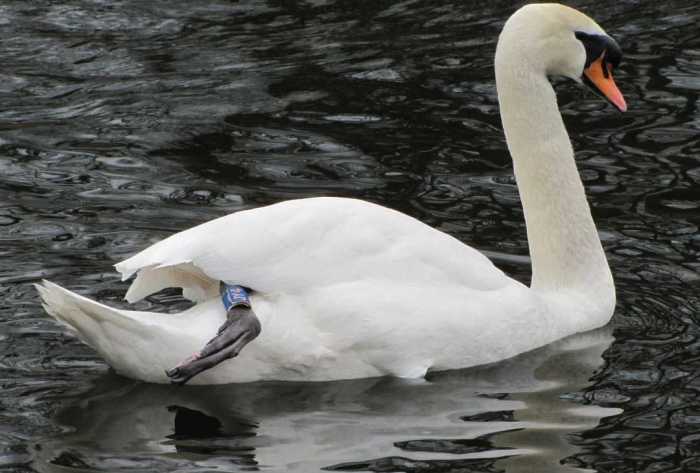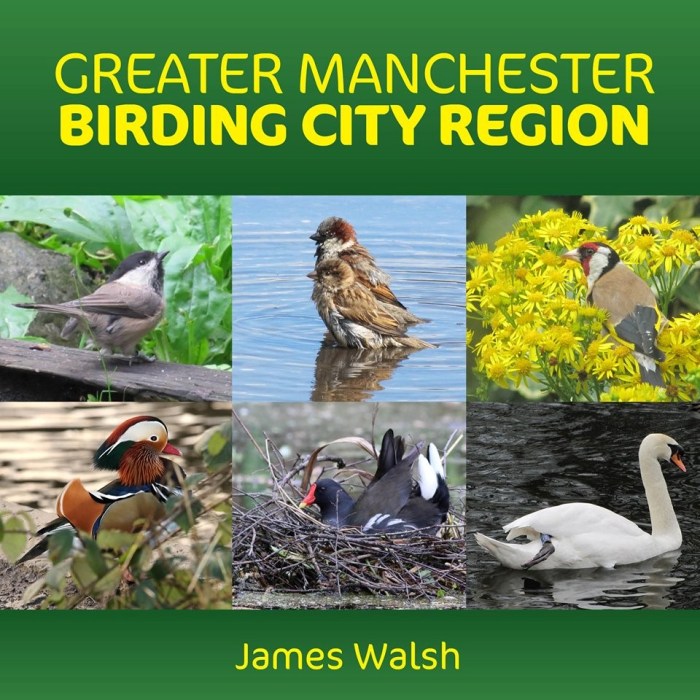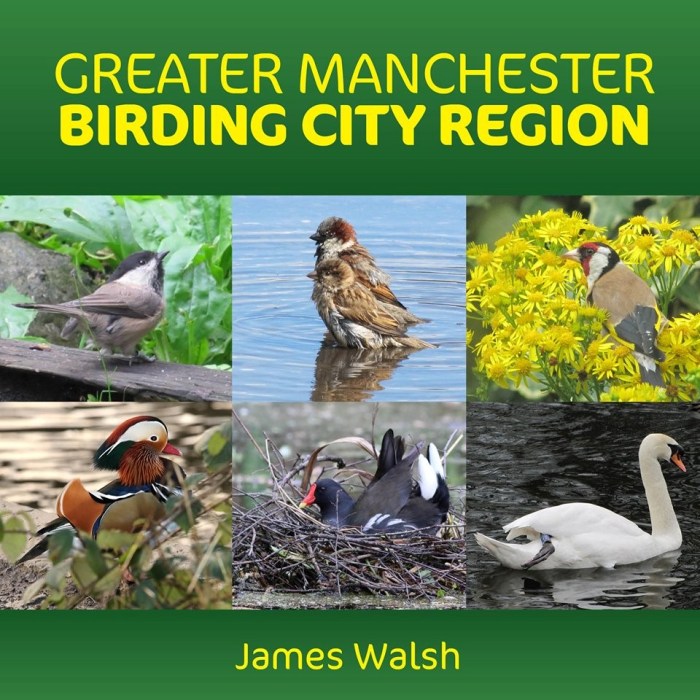Welcome to the world of manchester birding, where urban landscapes meet diverse birdlife. This comprehensive guide invites you to explore the vibrant birdwatching scene in Manchester, offering insights into the city’s hotspots, bird species, and conservation efforts. Join us as we uncover the hidden avian treasures that await discovery in this bustling metropolis.
Manchester boasts an impressive array of birdwatching locations, each offering unique experiences. From tranquil parks to bustling waterways, there’s a spot for every bird enthusiast. Our guide will take you on a journey through these hotspots, revealing the species they attract and the best times to visit.
Manchester’s Bird Watching Hotspots

Manchester, with its diverse green spaces and waterways, offers a rich habitat for a variety of bird species. From urban parks to tranquil reserves, the city boasts several renowned bird watching locations that cater to enthusiasts of all levels.
These hotspots provide unique opportunities to observe a wide range of birds, including resident species and migratory visitors. Each site offers its own distinct characteristics, attracting specific bird communities and providing excellent viewing conditions.
RSPB Sale Water Park
- Located in Trafford, RSPB Sale Water Park is a 145-acre wetland reserve that supports a diverse array of birdlife.
- The park features a variety of habitats, including open water, reedbeds, and woodland, which attract a wide range of species throughout the year.
- Notable species include great crested grebes, kingfishers, and a variety of warblers and finches.
- The reserve is well-equipped with hides and viewing platforms, providing excellent opportunities for birdwatching and photography.
Audenshaw Reservoirs
- Situated in Tameside, Audenshaw Reservoirs is a complex of three reservoirs that provide a haven for both resident and migratory birds.
- The reservoirs attract a variety of waterfowl, including tufted ducks, pochards, and shovelers, as well as waders and gulls.
- The site is also known for its breeding colony of little grebes, which can be observed during the spring and summer months.
- The reservoirs are surrounded by woodland and grassland, providing additional habitats for a variety of bird species.
Chorlton Water Park
- Located in South Manchester, Chorlton Water Park is a 120-acre park that includes two large lakes and a variety of other habitats.
- The park is home to a variety of waterfowl, including mallards, coots, and moorhens, as well as herons and egrets.
- The park’s woodland areas attract a variety of songbirds, including warblers, finches, and woodpeckers.
- Chorlton Water Park is a popular spot for birdwatching, with several hides and viewing platforms available.
Heaton Park
- Heaton Park is one of Manchester’s largest parks, covering over 600 acres of diverse habitats.
- The park includes woodland, grassland, and a large lake, which attract a variety of bird species throughout the year.
- Notable species include buzzards, sparrowhawks, and a variety of woodland birds, such as treecreepers and nuthatches.
- The park also supports a population of water birds, including grebes, ducks, and herons.
Bird Species Diversity
Manchester is a haven for birdwatchers, with a wide variety of species calling the city home. The River Irwell and its tributaries, as well as the city’s numerous parks and green spaces, provide diverse habitats for a range of bird species.
The following is a comprehensive list of bird species commonly found in Manchester, organized taxonomically:
Passeriformes (Perching Birds)
- Common Swift( Apus apus): A small, fast-flying bird with a long, narrow body and short wings. It has a dark brown back and white underparts, and a distinctive forked tail.
- House Sparrow( Passer domesticus): A small, plump bird with a brown back and gray head. It has a distinctive black bib and white cheeks.
- European Robin( Erithacus rubecula): A small, round bird with a bright orange breast and brown back. It has a distinctive white belly and black face.
- Blackbird( Turdus merula): A medium-sized bird with a black body and yellow bill. It has a distinctive orange eye-ring.
- Song Thrush( Turdus philomelos): A medium-sized bird with a brown back and spotted breast. It has a distinctive speckled belly and a melodious song.
Anseriformes (Waterfowl)
- Mallard( Anas platyrhynchos): A large duck with a green head and brown body. It has a distinctive white neck ring and a yellow bill.
- Mute Swan( Cygnus olor): A large, white bird with a long neck and orange bill. It is often seen on the River Irwell.
- Canada Goose( Branta canadensis): A large, brown goose with a black head and neck. It is often seen in parks and green spaces.
Columbiformes (Pigeons and Doves)
- Wood Pigeon( Columba palumbus): A large, gray pigeon with a white neck patch. It is often seen in parks and woodlands.
- Feral Pigeon( Columba livia domestica): A medium-sized, gray pigeon with a black band on its tail. It is often seen in urban areas.
Accipitriformes (Birds of Prey)
- Common Buzzard( Buteo buteo): A large, brown bird of prey with a distinctive white belly. It is often seen soaring over open countryside.
- Peregrine Falcon( Falco peregrinus): A medium-sized, gray falcon with a distinctive black hood. It is often seen hunting over urban areas.
Seasonal Bird Migration: Manchester Birding
Manchester experiences seasonal bird migration patterns, with species moving to and from the area in search of optimal breeding and feeding grounds. The timing and duration of these movements are influenced by factors such as temperature, food availability, and day length.
Species Migration Patterns
During spring and autumn, Manchester witnesses the arrival and departure of numerous migratory bird species. These include:
Warblers
Warblers, such as the Willow Warbler and the Chiffchaff, arrive in Manchester during spring to breed. They depart in late summer and early autumn, heading south for the winter.
Flycatchers
Flycatchers, like the Pied Flycatcher and the Spotted Flycatcher, also arrive in spring for breeding and depart in autumn.
Swallows and Martins
Swallows and Martins, including the Barn Swallow and the House Martin, are summer visitors to Manchester. They arrive in spring and depart in autumn, migrating to warmer climates for the winter.
Waders
Waders, such as the Curlew and the Redshank, pass through Manchester during their migrations between breeding and wintering grounds. They typically stop over in wetlands and mudflats to rest and feed.
Birdwatching Etiquette
Birdwatching in Manchester is a rewarding and enjoyable activity, but it is important to remember that we are guests in the birds’ natural habitat. It is essential to follow proper etiquette to minimize our impact on the birds and their environment.
Here are some key guidelines to follow:
Respect Wildlife
- Stay on designated trails and avoid entering sensitive areas.
- Do not approach birds too closely or attempt to touch them.
- Avoid making loud noises or sudden movements that could startle the birds.
- If you see a bird that is nesting or feeding its young, give it plenty of space and do not disturb it.
Minimize Disturbance
- Use binoculars or a spotting scope to observe birds from a distance.
- Avoid using flash photography, as this can be harmful to birds’ eyes.
- Do not leave litter or food scraps behind, as this can attract predators and harm the birds.
Use Appropriate Equipment and Techniques
- Use binoculars or a spotting scope with a magnification of 8x or 10x to observe birds from a distance.
- Wear camouflage clothing to blend in with the surroundings.
- Practice patience and wait for birds to come to you rather than actively pursuing them.
Local Bird Conservation Efforts

Manchester is home to a diverse range of bird species, and there are several organizations dedicated to protecting and conserving these populations.
These organizations work to protect bird habitats, monitor bird populations, and educate the public about the importance of birds. Their efforts are essential to ensuring the long-term survival of Manchester’s bird community.
Manchester Birdwatching Society
The Manchester Birdwatching Society is a non-profit organization dedicated to promoting the enjoyment and conservation of birds in the Greater Manchester area.
The society offers a variety of activities and programs, including guided bird walks, lectures, and workshops. They also work to protect bird habitats and advocate for policies that benefit birds.
Royal Society for the Protection of Birds (RSPB)
The RSPB is the UK’s largest wildlife conservation charity. They work to protect birds and their habitats across the UK, including in Manchester.
The RSPB manages several nature reserves in Manchester, including the Wythenshawe Park and Sale Water Park. They also work with local communities to create bird-friendly spaces and promote sustainable practices.
Manchester City Council
Manchester City Council has a responsibility to protect and conserve the city’s wildlife, including its bird populations.
Manchester Birding is a popular activity in the city, with many different species of birds to be seen. If you’re looking for a longer birding experience, consider taking one of the 5-day tours from Toronto . These tours will take you to some of the best birding spots in the area, and you’ll have the chance to see a wide variety of birds.
When you return to Manchester Birding, you’ll be able to share your experiences with other birders and help them find the best spots to see birds.
The council works to create and maintain bird-friendly habitats in parks and green spaces across the city. They also work with local schools and community groups to educate people about the importance of birds and how to protect them.
Birding Resources
Manchester offers a wealth of resources to support and enhance the birding experience for enthusiasts of all levels. From comprehensive websites to local groups, these resources provide valuable information, guidance, and opportunities to connect with fellow birders and expand your knowledge of the city’s avian diversity.
Websites such as the Manchester Birding website and the RSPB website offer detailed information on birdwatching hotspots, species identification, and upcoming events. These websites also provide interactive features like species checklists and online forums, allowing birders to share observations and connect with others.
Local Birdwatching Groups
- Manchester Ornithological Society:The oldest birding group in Manchester, with a long history of promoting birdwatching and conservation in the area.
- Lancashire Wildlife Trust:A conservation organization that offers guided birdwatching walks and events throughout the year.
- Manchester Birdwatching Group:A friendly and welcoming group that organizes regular birdwatching trips and activities.
Birding Tours and Workshops
Manchester offers guided birding tours and workshops led by experienced birders and ornithologists. These tours provide an excellent opportunity to explore Manchester’s diverse habitats, learn about bird species, and improve your birding skills.
Tours and workshops vary in their itineraries, costs, and target species, catering to different levels of experience. Some tours focus on specific habitats or bird groups, while others provide a more general overview of Manchester’s avifauna.
Beginner-Friendly Tours
- Manchester Birding 101:A beginner-friendly tour that introduces participants to the basics of birding, including bird identification, habitat preferences, and birding etiquette. The tour visits several accessible locations within Manchester and targets common bird species.
- Birds of the Mersey Valley:This tour explores the Mersey Valley, a renowned birdwatching site. Participants can expect to see a variety of waterfowl, passerines, and birds of prey. The tour is suitable for beginners and intermediate birders.
Intermediate and Advanced Tours
- Raptor Migration Watch:This tour focuses on observing the migration of raptors, including hawks, eagles, and falcons. Participants visit strategic vantage points to witness these majestic birds soaring through the sky.
- Night Birding Extravaganza:This unique tour takes place at night, allowing participants to experience the nocturnal world of birds. Owls, nightjars, and other nocturnal species are the main targets.
Workshops
- Bird Photography Workshop:This workshop teaches participants the techniques of bird photography, including camera settings, composition, and field ethics. Participants have the opportunity to practice their skills in the field.
- Bird Song Identification Workshop:This workshop focuses on developing the skills necessary to identify bird species by their songs and calls. Participants learn about the different vocalizations of birds and practice identifying them in the field.
Birdwatching for Beginners
Birdwatching is an accessible and rewarding hobby that can be enjoyed by people of all ages and abilities. In Manchester, there are many excellent places to go birdwatching, and with a little patience and practice, you can learn to identify many different species.
Basics of Bird Identification, Manchester birding
One of the most important things to learn when birdwatching is how to identify different species. This can be done by looking at the bird’s size, shape, color, and behavior. You can also use binoculars or a field guide to help you identify birds.
Using Binoculars
Binoculars are a great way to get a closer look at birds. When using binoculars, be sure to hold them steady and focus them on the bird. You can also use the binoculars to scan the area for birds.
Finding the Best Birding Spots
There are many great places to go birdwatching in Manchester. Some of the best spots include:* Heaton Park
- Platt Fields Park
- Chorlton Water Park
- Sale Water Park
- Wythenshawe Park
Closure
As you venture into the world of manchester birding, remember to embrace the principles of responsible wildlife viewing. By respecting the birds and their habitats, we can ensure that future generations continue to enjoy the wonders of Manchester’s avian diversity.
Join the local conservation efforts, support bird-friendly initiatives, and spread the word about the importance of bird conservation. Together, we can create a thriving and sustainable ecosystem for birds and humans alike.
Common Queries
Where are the best birdwatching spots in Manchester?
Manchester offers a variety of birdwatching locations, including Heaton Park, Salford Meadows, and the River Irwell. Each spot has its own unique characteristics and attracts different bird species.
What are some common bird species found in Manchester?
Manchester is home to a diverse range of bird species, including robins, blackbirds, blue tits, great tits, and wood pigeons. During migration periods, rarer species such as warblers and flycatchers can also be spotted.
When is the best time for birdwatching in Manchester?
Spring and autumn are generally considered the best times for birdwatching in Manchester, as many species migrate through the city during these seasons. However, there are birds to be seen all year round.
What are some tips for birdwatching in Manchester?
To enhance your birdwatching experience in Manchester, consider using binoculars, wearing camouflage clothing, and avoiding sudden movements. Respect the birds and their habitats, and always follow the principles of responsible wildlife viewing.



